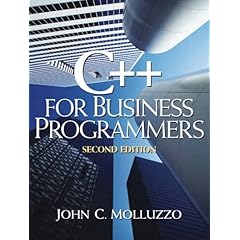
C++ for Business Programming, Second Edition By John C. Molluzzo - Pace University, New York Publisher : Prentice Hall Pub Date : August 02, 2005 Print ISBN-10 : 0-13-046700-6 Print ISBN-13 : 978-0-13-046700-3 eText ISBN-10 : 0-13-128899-7 eText ISBN-13 : 978-0-13-128899-7 Pages : 848
This text provides a student-friendly, highly readable introduction to C++ programming for beginning programming students, especially those majoring in Information Systems and Business. It guides readers through complete and clear descriptions of sample programs, with a wealth of exercises included along the way to help reinforce the important points of each chapter. Throughout the text, a strong emphasis is placed on business applications, rather than those in mathematics or computing.
Copyright Preface xv Changes From the First Edition xvi Chapter Overview xvii Part I: C++ Basics 1 Chapter 1. Introduction to C++ 1 Why Study C++? 1 Section 1.1. Our First C++ Program 3 Section 1.2. Integers and Arithmetic 20 Section 1.3. Solving a Problem with Integers 32 Section 1.4. Other Integer Data Types 36 Chapter Review 42 Chapter 2. Real Numbers 45 Section 2.1. Real Numbers 45 Section 2.2. Solving Problems with Real Numbers 52 Section 2.3. More on Arithmetic 64 Section 2.4. Three Difficulties When Displaying Decimal Numbers with cout 75 Chapter Review 78 Chapter 3. Iteration 80 Section 3.1. Relation Conditions 80 Section 3.2. Indefinite Iteration: The while and do Statements 83 Section 3.3. Solving a Problem with Indefinite Iteration 96 Section 3.4. Definite Iteration 105 Section 3.5. Nested Loops 118 Chapter Review 126 Chapter 4. Decision Making 128 Section 4.1. Basic Decision Making 128 Section 4.2. Compound ConditionsThe Logical Operators 139 Section 4.3. Nested if Statements 146 Section 4.4. The switch Statement 161 Chapter Review 172 Chapter 5. Functions 174 Section 5.1. The Function Concept 175 Section 5.2. User-Defined Functions that Return a Value 191 Section 5.3. Programs that Use Functions 203 Section 5.4. The C++ Math Library Functions 227 Chapter Review 231 Chapter 6. Arrays 234 Section 6.1. Basic Concepts 234 Section 6.2. Processing an Array: for Loops 242 Section 6.3. Sorting an Array 250 Section 6.4. Multidimensional Arrays 256 Chapter Review 264 Chapter 7. Pointers and C-Strings 266 Section 7.1. Pointers 266 Section 7.2. C-Strings 277 Section 7.3. Arrays of Strings and Pointers 290 Chapter Review 297 Chapter 8. Pointers, Arrays, and Functions 299 Section 8.1. Pointers, Reference Variables, and Functions 299 Section 8.2. Arrays and Functions 309 Section 8.3. Strings and Functions 318 Section 8.4. The Standard Library String Functions 326 Section 8.5. Character Classification and Conversion Functions 336 Section 8.6. Dynamic Memory Allocation 351 Chapter Review 360 Chapter 9. User-Defined Data Types and Tables 363 Section 9.1. The typedef and enum Statements 364 Section 9.2. Structures 371 Section 9.3. Arrays of Structures: Tables 379 Section 9.4. Structures, Functions, and Pointers 407 Chapter Review 424 Part II: Object-Oriented Programming 426 Chapter 10. The string Class: An Introduction to Classes and Objects 426 Section 10.1. Objects, Classes, and Object-Oriented Systems 427 Section 10.2. Introduction to string Objects 430 Section 10.3. Operations on string Objects 438 Section 10.4. Making Decisions with Strings 444 Section 10.5. Functions and string Objects 446 Section 10.6. Manipulating string Objects 451 Section 10.7. Putting Strings to Work 458 Section 10.8. Arrays of Strings 470 Chapter Review 473 Chapter 11. Programmer-Defined Classes and Objects 476 Section 11.1. Declaring Objects and Classes 476 Section 11.2. A More Useful Class Accessor and Mutator Methods 487 Section 11.3. Constructor Overloading and Destructors 496 Section 11.4. Default Arguments and Object Assignment 504 Section 11.5. General Function Overloading and Function Templates 511 Chapter Review 517 Chapter 12. Manipulating Objects 519 Section 12.1. Using Arrays, Pointers, and Dynamic Memory Allocation 520 Section 12.2. The Copy Constructor 528 Section 12.3. Using const with Classes 540 Section 12.4. Objects, Functions and Pointers 556 Section 12.5. Dynamic Allocation of Objects 581 Section 12.6. Static Data Members and Functions 588 Chapter Review 598 Chapter 13. Inheritance 600 Section 13.1. Inheritance 601 Section 13.2. Functions in Class Hierarchies 618 Section 13.3. Polymorphism 629 Section 13.4. Abstract Base Classes 649 Chapter Review 661 Chapter 14. Files 664 Section 14.1. Input/Output Streams 665 Section 14.2. Processing a File One Character at a Time 686 Section 14.3. Random File Access 692 Section 14.4. Binary Sequential File Processing 699 Section 14.5. Random Record Input/Output 709 Chapter Review 727 Chapter 15. Special Topics: Friends, Operator Overloading, Macros, and Inline Functions 730 Section 15.1. friend Functions 731 Section 15.2. Overloading Basic Arithmetic Operators 738 Section 15.3. Overloading Assignment and the this Pointer 745 Section 15.4. Overloading the Insertion and Extraction Operators 754 Section 15.5. Overloading Compound Assignment Operators 763 Section 15.6. Overloading Relational Operators 768 Section 15.7. Overloading Unary Operators 775 Section 15.8. Macros and Inline Functions 779 Chapter Review 788 Appendix A. Computers and Data 791 Section A.1. A Model Computer System 791 Section A.2. Data RepresentationCharacters 794 Section A.3. Data RepresentationIntegers 797 Section A.4. Data RepresentationReal Numbers 799 Exercises Appendix A 800 Appendix B. Program Control 802 Section B.1. Sequence 802 Section B.2. Selection 803 Section B.3. Iteration 808 Section B.4. Combinations 812 Index
 120917.rar
大小:(3.54 MB)
120917.rar
大小:(3.54 MB)
只需: 50 个论坛币
马上下载
本附件包括:
- C++ for Business Programming - 2nd Ed 2005 - John C. Molluzzo - Prentice Hall.chm
[此贴子已经被作者于2007-5-28 9:21:01编辑过]

 扫码加好友,拉您进群
扫码加好友,拉您进群